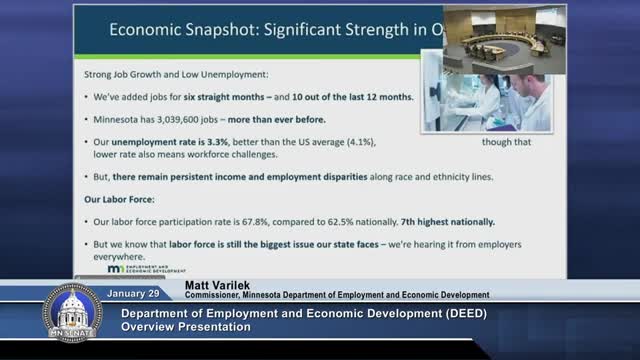Minnesota hosts 113 business expansions in 2024 creating 2000 new jobs
January 29, 2025 | 2025 Legislature MN, Minnesota
This article was created by AI summarizing key points discussed. AI makes mistakes, so for full details and context, please refer to the video of the full meeting. Please report any errors so we can fix them. Report an error »

Minnesota's labor force participation remains robust at 67.8%, significantly higher than the national average of 62.5%. However, state officials warn that an aging population poses challenges to maintaining this rate. During a recent meeting of the Committee on Jobs and Economic Development, experts highlighted the need for strategies to attract and retain younger workers as retirements increase.
Commissioner Verloc emphasized the importance of creating satisfying career paths for young Minnesotans to combat potential declines in workforce participation. He noted that while Minnesota ranks well in business environments—6th according to CNBC and 4th by U.S. News & World Report—the state must continue to support both large and small businesses to sustain economic growth.
The meeting also celebrated the expansion of Solventum, which is expected to increase Minnesota's Fortune 500 companies from 17 to 18. This expansion is a testament to the state's supportive business climate, bolstered by significant investments from the 2023 budget, totaling $1.8 billion.
Small business applications are on the rise, with Minnesota showing strong survival rates for new enterprises. In 2024, the state tracked 113 business expansions, resulting in $12 billion in outside investment and the creation of thousands of jobs. The job creation engine is currently thriving, with projections indicating that job creation in the first half of 2025 could surpass last year's totals.
As the meeting concluded, officials reiterated their commitment to effective implementation of funding and programs designed to foster economic development and job creation across Minnesota. The focus remains on collaboration with the legislature to navigate the challenges ahead while capitalizing on the state's economic strengths.
Commissioner Verloc emphasized the importance of creating satisfying career paths for young Minnesotans to combat potential declines in workforce participation. He noted that while Minnesota ranks well in business environments—6th according to CNBC and 4th by U.S. News & World Report—the state must continue to support both large and small businesses to sustain economic growth.
The meeting also celebrated the expansion of Solventum, which is expected to increase Minnesota's Fortune 500 companies from 17 to 18. This expansion is a testament to the state's supportive business climate, bolstered by significant investments from the 2023 budget, totaling $1.8 billion.
Small business applications are on the rise, with Minnesota showing strong survival rates for new enterprises. In 2024, the state tracked 113 business expansions, resulting in $12 billion in outside investment and the creation of thousands of jobs. The job creation engine is currently thriving, with projections indicating that job creation in the first half of 2025 could surpass last year's totals.
As the meeting concluded, officials reiterated their commitment to effective implementation of funding and programs designed to foster economic development and job creation across Minnesota. The focus remains on collaboration with the legislature to navigate the challenges ahead while capitalizing on the state's economic strengths.
View full meeting
This article is based on a recent meeting—watch the full video and explore the complete transcript for deeper insights into the discussion.
View full meeting
